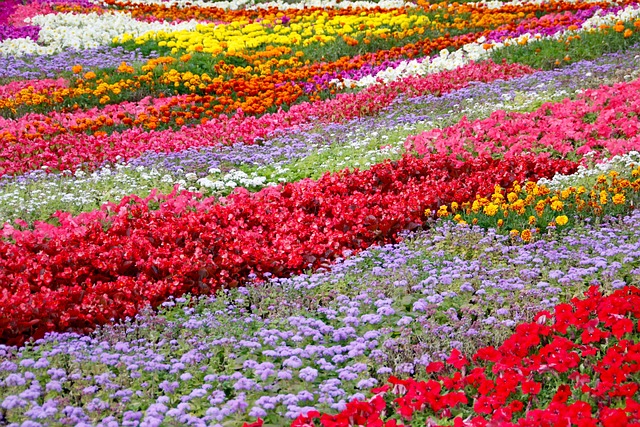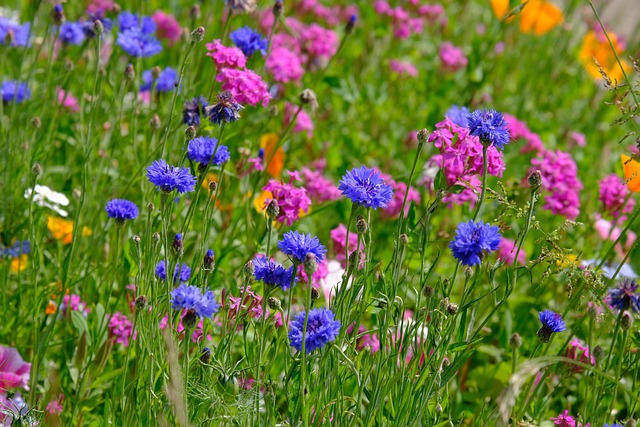In addition to giving your landscape a polished, polished appearance, adding edging has other practical benefits. Conventional landscaping edging materials, like steel, stone, or brick, keep grass out of your beds and stop plants from taking over your lawn. However, given how popular somewhat overgrown appearances like the cottage garden design have become, you could feel that this minimalist style is too severe for a garden.

Add edging plants to your borders for landscaping. Plant them next to edging materials to reduce the effect, or use lower-growing plants alone to demarcate distinct garden sections. With fresh blooms and leaves emerging from spring to autumn, edging plants serve as the front edge of your flowerbeds and should look attractive regardless of the time of year or growing circumstances. Colorful border plants are extra points since they complement the winter scenery.
Using Edging Plants: A Guide
The finest plants for landscape edging draw the eye and direct it forward, drawing attention to a garden path or other feature to assist guide foot traffic. A flower bed may be made visually more exciting by surrounding it with vibrant border plants that also serve to distinguish the planting area from neighboring features. To keep a more organized style, think about keeping a consistent look: Employing a single kind of edging plant—for instance, any of the several evergreen edging plants, such as creeping or blue star juniper—creates a dependable border for the garden’s interior sections, which change with the seasons.
Assess Your Illumination Level
Determine how much sunshine your area receives before selecting your bordering plants. Plants that are exposed to direct sunlight for eight or more hours every day will thrive. Select plants that thrive in partial shade if the bed receives fewer than eight hours of direct sunshine every day due to its shady nature. See which options are ideal for your landscape by looking through our listings below.
Sun-loving edging plants
Boxwood
Boxwood is among the most tasteful evergreen border plants. Select little cultivars like ‘Morris Midget’ and ‘Wee Willie’ to form a neat hedge along the edges of your flower beds. Every year, shear your boxwood to keep it in its proper size and form. Although the hardiness of boxwood varies, it typically grows in Zones 4–8.
Day Lily
Daylilies are a great plant for spring through autumn landscape border, with graceful mounds of green leaves. Midsummer sees the plant put out vivid flower spikes; once blossoms fade, clip away flower stems to maintain plants clean. Select from a choice of hues including pink, red, orange, and yellow. Zones 3–10 are where most are hardy.
The Lady’s Mantle
This lovely perennial yields neat piles of green leaves with a scalloped appearance. Water and dewdrops are captured by the delicate hairs on the leaf, which often adds a little additional glitter. Early summer brings clusters of small, chartreuse flowers blooming on lady’s mantle. In Zones 4–7, this low-growing shrub creates an exquisite edging plant.

Lavender
Lavender is a resilient, fragrant edging plant that thrives in heat, sun, and dryness. In Zones 5–10, this plant is hardy; in warmer climates, it becomes evergreen. Gather the white, blue, or purple blooms for drying or arranging in bouquets.
Rose Moss
Long-blooming moss roses are unaffected by dry circumstances or intense sunshine. This gorgeous annual with jewel-tone blooms spreads quickly to provide a vibrant carpet of flowers and leaves. Measuring just 6 inches in height, it’s ideal for bordering low-growing plant beds.
Sedum
Sturdy, clumping sedum types like ‘Matrona’ provide the landscape a touch of autumn while also forming a tidy border for taller plants behind them. This perennial withstands heat and drought rather well. Pollinators are drawn to sedum types because of their blooms, which are hardy in Zones 3–10.
Spending Thrift
This lovely perennial creates neat little mounds of green leaves. Bright pink or white blooms in rounded clusters emerge in late spring or early summer. In Zones 3–9, thrift prefers full sun and very well-drained soil.
thyme
Thyme is a tasty and aromatic herb that grows into a pile of leaves that is covered with pink or white blossoms throughout the summer. In Zones 4–9, low-growing thyme makes a great edging plant when placed in front of low-growing perennials or in a herb garden.
Zinnia
Zinnias are an annual that grow easily from seed and come in a wide variety of colors and sizes. Colorful edging plants may be made from shorter, dwarf kinds or seed mixes like ‘Thumbelina’ or ‘Short Stuff’.
Plants for Shade Edging
Astilbe
Astilbe is a gorgeous accent to any shade garden in Zones 3–8 because of its feathery flower plumes and fern-like leaves. The neat form of this drought-tolerant perennial makes it a suitable option for landscaping edging. The hues of flowers are red, pink, and white.
The epimedium
The lively tiny perennial epimedium, also known as barrenwort, is a popular border plant for gloomy landscaping beds. It blooms in spring with spidery flowers that are colored in colors of pink, purple, orange, yellow, and white. A lot of types have lovely foliage that becomes bronze in the fall. This hardy shrub is hardy in Zones 5–9 and resistant to drought.
Begonia
Begonias are an annual plant with a powerful floral power that thrive in well-drained, rich soil and warm weather. Many types are excellent choices for edging plants since they are less than 12 inches tall.
Coleus
The vibrant leaves of this annual will enliven a drowsy shadow garden. Coleus comes in a wide variety of cultivars and color combinations. (Some will grow in the sun as well.) To keep these quickly spreading plants at the ideal height for bordering your garden bed, pinch them back.
Ferns
Numerous ferns are low-maintenance edging plants that thrive in Zones 3–9’s wet soil and range from partial shade to deep shade. Select plants that grow slowly at the front of a garden bed. Some ferns expand fast, so be mindful of that. If they start to crowd out neighboring plants, you can split them.
Hellebore
Hellebores are distinguished by their leathery evergreen leaves and late winter or early spring blooms. Beautiful flowers in white, cream, pink, rose, bicolors, and even almost black are available in many kinds. Plant many plants of the same kind to create a uniform border. Zones 4–9 can tolerate hellebore.
Coral bells
Coralbells are a high-impact border plant because of their gorgeous foliage in tones of green, yellow, and burgundy, which is capped with tiny flower spikes throughout the summer. This hardy perennial thrives in Zones 4–9 on a range of soil types and in dry circumstances.
